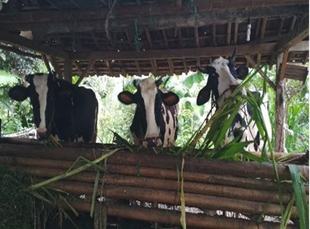PENGARUH pH LENDIR MUKOSA VAGINA SAAT BIRAHI TERHADAP PERSENTASE KEBUNTINGAN (Conception Rate) PADA SAPI PERAH DI KUD TANI WILIS KABUPATEN TULUNGAGUNG DAN KSU TUNAS SETIA BARU KABUPATEN PASURUAN
Downloads
Basya S. 1993. Perimbangan Optimal Hijau-an dan Konsentrat dalam Ransum Sapi Perah Laktasi. Balai Penelitian Ternak, Bogor. 41. Farid, M. dan N. Sukesi. 2011. Pengembangan Susu Segar Dalam Negeri Untuk Pemenuhan Kebutuhan Susu Nasional. Buletin Ilmiah Litbang Perdagangan.5(2): 1- 26. Hariadi, S.,S. Hardjoranjoto, Wurlina, H. A. Hermadi, B.Utomo, Rimayanti, I. N. Triana dan H, Ratnani. 2011. Buku Ajar Ilmu Kemajiran pada Ternak. Cetakan Pertama. Airlangga University Press. Surabaya. 1-91. Prasdani, W. A., S. Rahayu, dan M.S.Djati. 2015. Level of Esterogen and Cervical Mucous pH as Indicator of Estrus After Calving Towards The Provision of Selenium-vitamin ETM on Diary Cow Frisien Holstein (FH). International Jour-nal of ChemTech Research. 7(1) : 190-195.
Sidik, R. 2004. Komoditas dan Bangsa Ternak Perah. Sub Bagian Produksi Ternak. Fakultas Kedokteran Hewan. Universitas Airlangga. Surabaya. Suharto, K 2003. Penampilan Potensi Reproduksi Sapi Perah Friesian Holstain Akibat Pemberian Kualitas Ransum Berbeda dan Infusi Larutan Iodium Povidon 1% Intra Uterin Fakultas peternakan UN-DIP. Semarang. Susilawati, T. 2011. Tingkat Keberhasilan Inseminasi Buatan dengan Kualitas dan Deposisi Semen yang Berbeda pada Sapi Peranakan Ongole. J. Ternak Tropika. 12(2): 15-24. Tsiligianni, T ., Amiridis, GS., Dovolou. E., Menegatos, I., Chadio, S., Rizos, D., and Gutierrez-Adan, A. 2011. Association between physical properties of cervical mucus and ovulation rate in superovulated cows. The Canadian Journal of Veterinary Research. 75: 248-253. Verma, K. K., S. Prasad., A. Kumaresan, T. K. Mohanty, S. S. Layek, T. K. Patbandha and S. Chand. 2014. Characterization of Physico Chemical Properties of Cervical Mucus in Relation to Parity and Conception Rate in Murrah Buffaloes. Veterinary World. 7(7): 467-471.
Ovozoa by Unair is licensed under a Creative Commons Attribution-ShareAlike 4.0 International License.
1. The journal allows the author to hold the copyright of the article without restrictions.
2. The journal allows the author(s) to retain publishing rights without restrictions
3. The legal formal aspect of journal publication accessibility refers to Creative Commons Attribution Share-Alike (CC BY-SA).
4. The Creative Commons Attribution Share-Alike (CC BY-SA) license allows re-distribution and re-use of a licensed work on the conditions that the creator is appropriately credited and that any derivative work is made available under "the same, similar or a compatible license”. Other than the conditions mentioned above, the editorial board is not responsible for copyright violation.




































